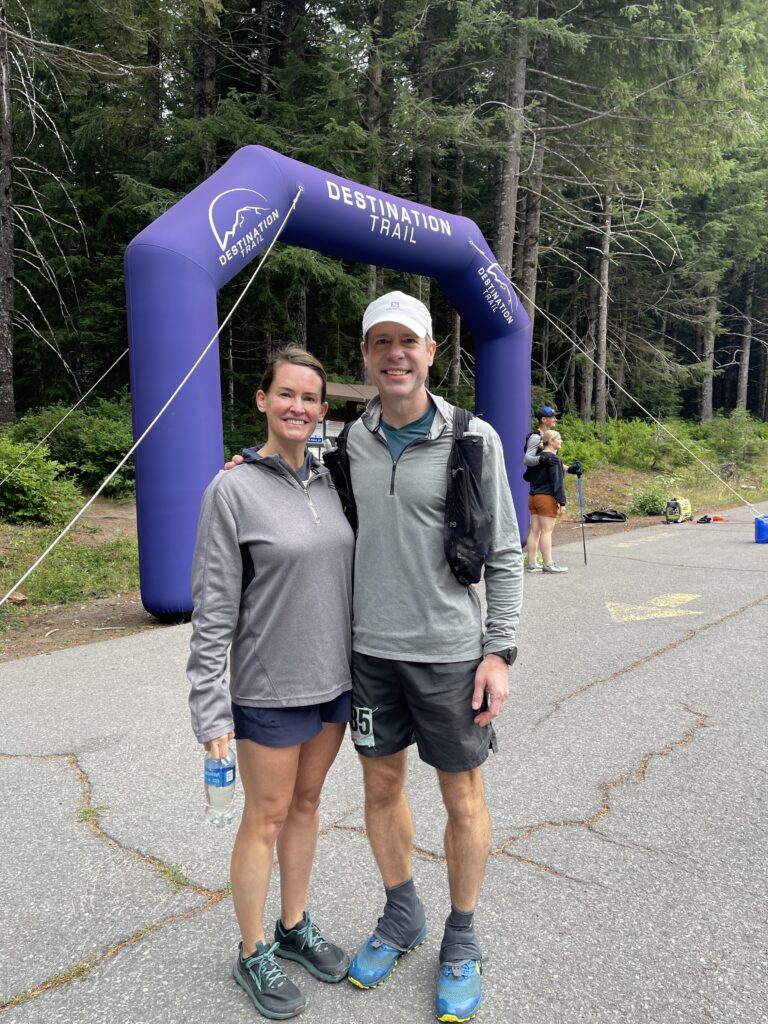
Note
I’m testing a different format for this race report than I’ve used for the others I’ve written. I’ve added a section after the end of the narrative in which I provide commentary regarding some of the things I experienced or observed, as well as lessons that I either learned or was reminded of. If, after reading my story you want just a few more points to consider, scroll past the finish line photos and you’ll find a little additional food for thought.
Race Preliminaries
My fourth Bigfoot 200 was an unrelenting battle fought in the rugged wilderness of the Cascade Mountains. Three other runners moved through the course at roughly the same pace as I did, creating the sense of a smaller competition within the context of the larger, 206-person race. Despite the pressure of having tough competitors so close throughout the event, it was the most even-keeled 200-mile race of the thirteen I’ve run since 2015. I didn’t battle the energy swings that I’ve often experienced, and, miraculously, I didn’t experience nausea a single time throughout the race.
But I’m getting ahead of myself.
The night before the race I slept almost seven hours, an accomplishment that sent my mood into the stratosphere when I crawled out of bed the next morning. I’ve had trouble sleeping before every one of my 200-milers aside from the first two in 2015 and 2016. The most I slept before any of the others was 5 ½ hours, and the least was 30 minutes. This year I would stand at the start line of Bigfoot without feeling sleep-deprived. I had energy, I felt excited. I smiled and gave Heather—my girlfriend and sole crew member—a big hug and a kiss. I already knew this was going to be a good race.
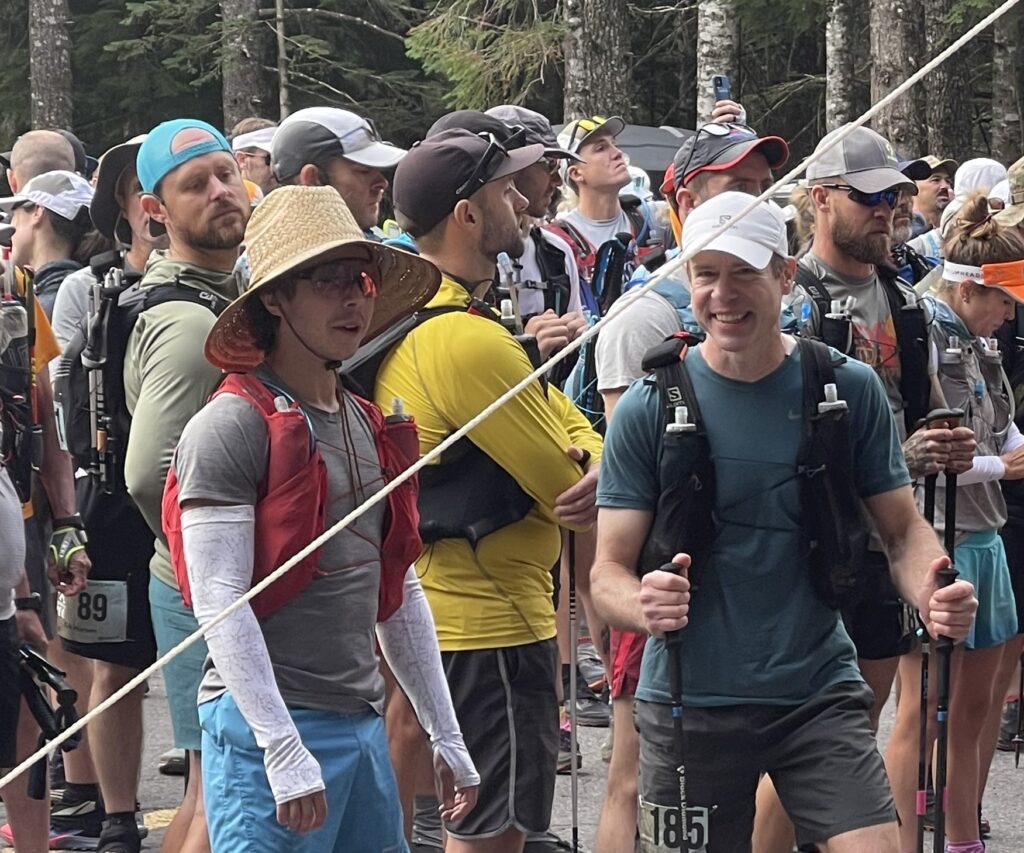
Start to Coldwater Lake (Mile 0 to mile 47)
Saturday August 13, 2022, began as a cool, overcast day with no forecast for rain. It was perfect weather for the start of the race. The runners gathered behind the inflatable arch that marked the start line, eager to get on the trail. Ahead of us were 209.2 miles, countless steep climbs, technical trails, fallen trees to crawl over, streams and rivers to cross, and more than 46,000 feet of cumulative vertical ascent.
When the starting horn blew, Jovica Spajic, a Serbian runner, took off like his hydration pack was on fire. I knew his goal was to beat the course record, and I believed that he had it within him to achieve that or to come close. Four years earlier, I had run in improvised partnership with him throughout the Moab 240. I had also competed with him at a couple other 200-milers, so I was familiar with his style and strengths. I didn’t entertain any thoughts about attempting to mimic his initial pace. Instead, I let him go on almost as if he was in a separate race. Either his aggressive pace would pay off with a win, or he would crash 150 miles from now. Knowing Jovica, I was betting he could sustain his pace or he wouldn’t even be attempting it. Unless something went poorly for him, my battle would be for the podium, not for the win.
I began the race conservatively, as I always do. I made a point of being up with the front pack, but I didn’t care where I was within it. I didn’t think about the distance remaining or the seemingly endless challenges I knew from experience I would have to overcome. I focused on the terrain in front of my feet, I focused on the peaceful rhythm of my movement, and I allowed my mind to embrace the moment in which I was existing.
For a few early miles, I ran with Jake Donath, Nick Davis and another runner. We talked about some of the lessons we’d learned in our 200-milers, and we helped each other move efficiently through the boulder field by providing multiple pairs of eyes to find the best route through the maze. Little did I know that Jake would be part of the small group that would be competing for places on the podium for the last 150 miles of the race.
Twelve miles along the course, I breezed through Blue Lake aid station with only a quick stop to fill some bottles. I was carrying enough calories to get me all the way to Johnston Ridge aid station, mile 40, so there was no need to waste time getting food from Blue Lake. Next up was a sizeable portion of the Mt. Saint Helens blast zone, a section that had withered and dehydrated many runners in the past, including me. This year, the mild weather put a damper on the section’s bite, making the traverse of the blast zone uneventful and reasonably fast.
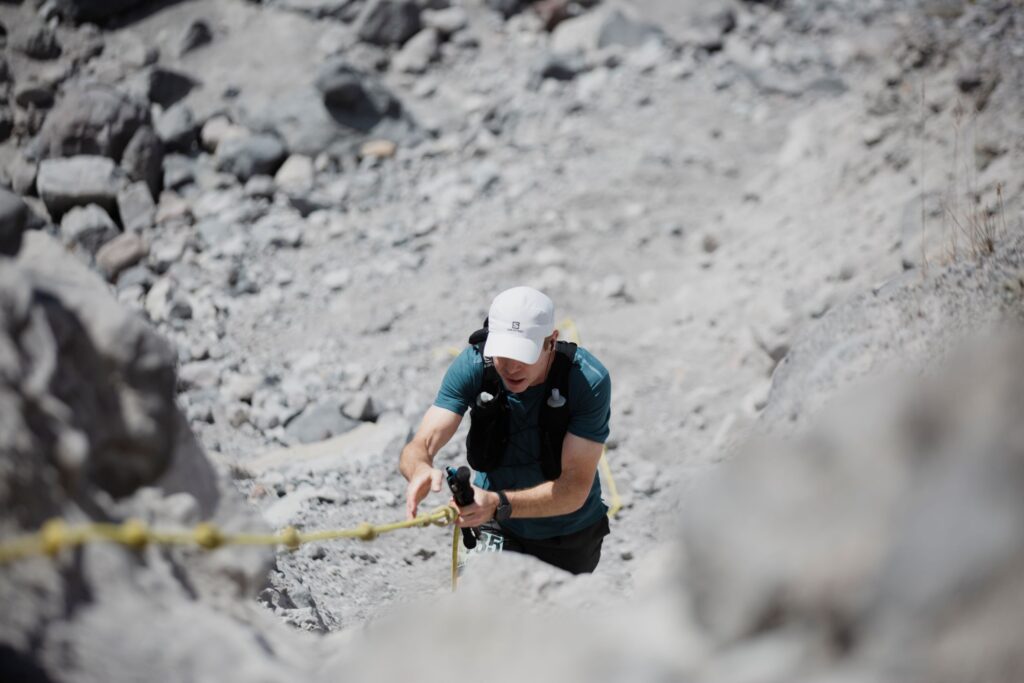
Soon, I was ascending the dirt road along an out-and-back to Windy Ridge aid station, mile 30. I’d only just started the ascent when a familiar black and yellow jersey caught my eye. Jovica Spajic was descending after already completing his aid station visit. This put him about 3 miles ahead of me. He and I stopped and embraced. He was in good spirits and shared with me that his biggest joy was the baby who had entered his family’s life seven months earlier. I congratulated him on his good fortune, we wished each other well, and I continued my ascent while he sped down the hill to make the turn toward Johnston Ridge. That would be the last time I’d see him. He would continue widening his lead on the rest of the pack for the entire race, and would go on to seize the win by a wide margin.
As I was approaching Windy Ridge aid station, I saw Mike Asmus heading the opposite direction. I expected that there might be a couple more runners besides Mike who had arrived at the aid station before me, but Jason, one of the race photographers, called out to me that I was in third place. This was a nice surprise even though it was somewhat meaningless this early in a 209-mile race.
I was feeling great, and knew I could continue relying on the calories in my pack to sustain me, so I restricted my activity at Windy Ridge to eating a couple banana slices while a kind volunteer filled my bottles. Inside of two or three minutes, I was heading for the aid station exit.
It wasn’t long after Windy Ridge aid station that five runners started to break away from the pack. Jovica was well ahead of everyone, while the other four of us were running in the same vicinity of one another although we weren’t actually running together. In fact, there was a 1-hour spread between the lead and trailing runners in this group, and the only time I ran with any of the other three guys during the entire race lasted all of thirty minutes during and after the descent to Lewis River around mile 100. The rest of the time, none of the others were anywhere within sight except when we occasionally bumped into each other at the aid stations or passed each other on the trail. The four runners consisted of Jake Donath, Mike Asmus, Chris Price and me. It was the four of us who would contend for the 2nd and 3rd place podium spots for the last 180 miles of the race. Cameron Zimmerman, a runner who had a strong top-10 finish at Tahoe 200 in 2019, would press the group of four for the first 70 of those 180 miles, but ended up dropping at Lewis River.
The route to Johnston Ridge aid station is an easy one by Bigfoot standards. Although it does have a lot of exposure to the afternoon sun, it’s only 10 miles long and includes just 1600 feet of ascent. After running back down the dirt road from Windy Ridge to the single-track trail, the course is relatively flat for all but the last 4 miles. It is there that most of the climbing is concentrated in the form of a ridgeline, atop which sits an observatory with spectacular views of the Mt. Saint Helens volcanic crater.
When I arrived at Johnston aid station, mile 40, I burned six minutes filling up a bottle or two and being indecisive regarding whether I wanted to consume any extra calories beyond what I was already carrying. Then I got moving again on the easiest section of the entire course: the descent to Coldwater Lake. It was 6 miles of smooth, runnable single-track that I took full advantage of, pushing myself a bit faster than I had during this section in any of my other three Bigfoot races. It felt like only a few minutes before I arrived at the parking lot that was home to Coldwater Lake aid station.
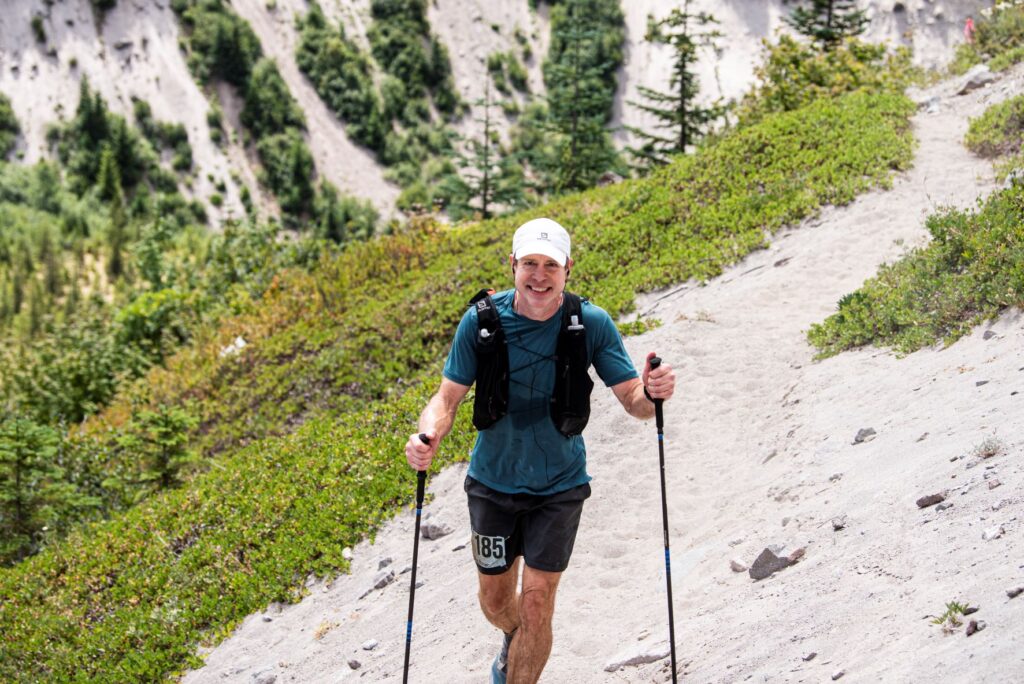
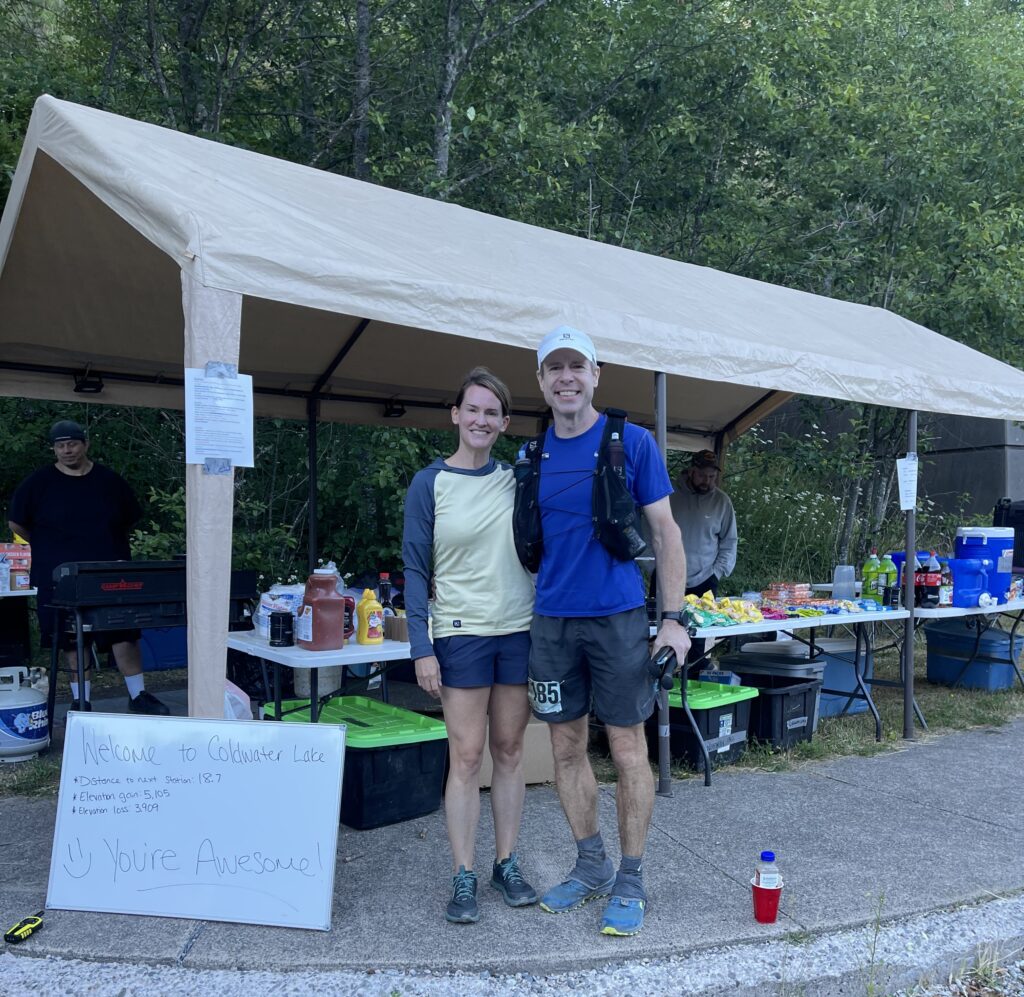
Coldwater Lake to Spencer Butte (Mile 47 to Mile 96)
Heather was a welcome sight as I ran into Coldwater Lake aid station, guiding me to the check-in and then leading me to where she had parked our crew vehicle. I handed Heather my pack and then sat in a camping chair she had set up for me. My new pack had already been prepared, so Heather grabbed the smoothie I requested and checked on my general condition. Having not taken advantage of the food at the previous aid stations, I wanted to use Coldwater as an opportunity to absorb some extra calories. I quickly polished off the smoothie, drank some other calorically dense fluids, and was on the move ten minutes later.
After following the gently rolling trail along the northwest side of the lake, I crossed the bridge which marks the beginning of the big ascent. It isn’t the toughest climb on the course, but it includes more than 4000 feet of vert, most of which is concentrated into the first 4 miles of the climb.
Even before the sun began setting I realized I’d never made it this far up the ascent before dusk. I don’t track my splits during a race, so it was a bit of a revelation to me that I was ahead of my 2018 pace. I always draw up a plan that outlines my estimated splits in advance, but this is almost entirely for the benefit of the crew so they have a rough idea how long it’s going to take me to get from one aid station to the next. It’s only on rare occasions when I actually ask my crew how I’m performing against my planned splits. I run by feel, relying on my experience to tell me when my body can push harder and when I need to ease off the gas pedal. Relying on a GPS watch to determine when I should speed up and when to slow down has always seemed like a bad idea that would just add meaningless pressure rather than allowing my mind to remain in tune with the present moment.
After the climb to Mount Margaret, I enjoyed the downhill miles the rest of the way to Norway Pass aid station, where Heather was again waiting for me. Mike Asmus was already at the aid station when I came in, and he left before I did. He’d been holding the 2nd place position since before Windy Ridge, and I’m sure he had no intention of giving it up easily.
My stops at Norway and the next aid station, Elk Pass, took longer than they should have as I worked my way through the night. Combined, I spent a total of almost an hour at the two aid stations. At Elk Pass, mile 76, I felt particularly worn out, and Heather later commented that it was at that aid station when I looked more depleted than at any other time during the race. I wasn’t feeling any nausea, but my stomach was just a bit uneasy. I laid down on a cot for a couple minutes, not because I thought I’d fall asleep, but rather in an effort to clear my mind and settle my stomach. Elk Pass ended up being even more of a yo-yo station than Norway. Mike arrived first, then I arrived, then Mike departed right before Jake showed up, then I departed before Jake got moving, and finally Chris arrived just after Jake left.
Even after I left Elk Pass my energy level was low. I’d remained in 3rd place for roughly the last 50 miles but, between longer aid station stops and the slowing of my pace in the wee hours of the still-dark morning, both Jake Donath and Chris Price passed me sometime after departing Elk Pass. I had dropped back to 5th.
It was nearly 8 AM on Saturday, 23 hours into the race, when I jogged out from under the bright green leaves of the trees and onto the dirt road that would take me the final tenth of a mile to where the Road 9327 aid station stood with its white-canopied tents. It charged me up to see Heather, particularly since it was going to be another 36 miles before I’d see her again. Mika Thewes was captaining the aid station, and Mike Groenenwegen was there volunteering and cheering people on. Both Mika and Mike were exceptional 200-mile runners I’d run with in the past, and they did a nice job encouraging me. It was a refreshing stop, and my body’s battery felt fully recharged within the first mile or two of leaving the aid station. From there, it was a short, 11-mile jaunt to Spencer Butte aid station.
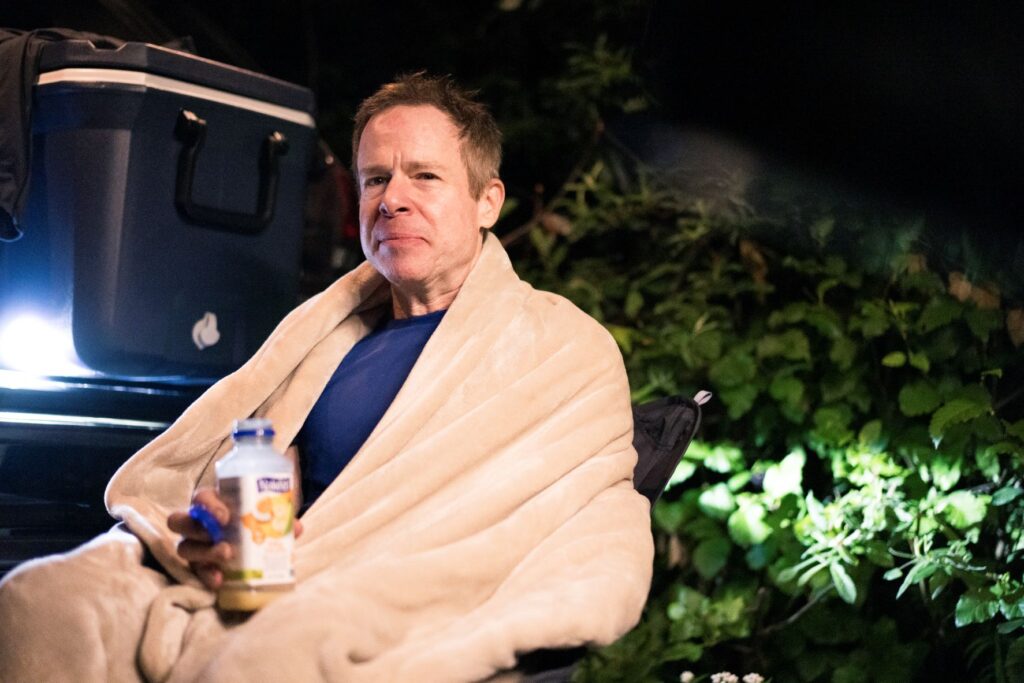
Spencer Butte to Chain of Lakes (Mile 96 to Mile 144)
Chris and Jake both hit Spencer Butte aid station ahead of me. Jake was already gone before I arrived, but Chris was still getting refueled. Mike was even farther ahead. The fact that I’d dropped back to fifth place spurred me on, and I made a conscious decision to move through Spencer Butte quickly, stopping only long enough to fill my bottles. I was feeling good and, since I wasn’t going to see Heather until Quartz Ridge for another 25 miles, I was already carrying enough calories to get me to Lewis River aid station without eating anything at Spencer Butte. I made it out of the aid station ahead of Chris, but my advantage didn’t last long.
The route out of Spencer Butte starts with a couple miles of easy, paved road before it turns onto single-track trail for the big descent toward Lewis River. The descent alternates between steep, straight-down-the-mountainside sections and more gently descending switchback sections. Lush, green groundcover often hides the trail, making the footing just a little precarious. Deciding to play it safe, I started the descent more timidly than I might ordinarily have taken it. I hadn’t gone far when, on a switchback, I caught a glimpse of Chris and his pacer not far behind me. It was clear they were quickly narrowing my short lead.
They caught up to me just a couple minutes later, and I stepped aside to let them pass. As I moved back on the trail behind them, Chris accelerated to a rapid, edgy pace that seemed to be a lot faster than his pace when he had been approaching me from behind. I interpreted his acceleration as an attempt to send me the message that he was feeling strong, and that there was no sense trying to keep up with him.
For good or ill, I immediately decided I was not going to let Chris play that game without a counter-move on my part.
I launched myself down the hill in a blaze of speed to match what Chris and his pacer were delivering. And boy were they delivering! When we hit the next section of switchbacks only a couple hundred meters later, I knew Chris could see me behind him. He knew I had sped up and was in close pursuit. Chris might or might not have been trying to send a message to me with his strong descent, but I was definitely trying to communicate a message to him by matching his pace: even when you think I’m tired and slowing down, I still have it in me to put up a fight.
I have no idea if Chris had intended to run down the entire descent that aggressively, or if he kept it up to see if he could drop me, but in either case we descended those 2000 vertical feet faster than I had in any of my previous times running Bigfoot. I had a mild concern that I might pay the price later in the race if I ended up trashing my quads with such a fast, steep downhill pace. But I threw caution to the wind, and matched Chris step for step while loving every moment of the reckless descent.
We blew past Jake Donath near the bottom of the hill. He appeared to speed up after we passed him, but then he apparently thought better of it and eased back.
When the trail leveled out to parallel the Lewis River and its series of beautiful waterfalls, Chris finally slowed down to a more sustainable pace. I remained close behind him for a short period before he invited me to pass. This officially put me in third place, but Chris remained close enough behind me that we arrived at Lewis River aid station only a couple minutes apart. Mike Asmus was already at the aid station when I arrived, and Jake stepped in only a few more minutes behind Chris. This was the only point in the race when all four of us were together. Mike appeared to be taking his time, and the other two guys were just getting settled.
Not wanting to give up what I had gained on the descent, and seizing the opportunity to take 2nd place from Mike, I repeated the tactic I had used at Spencer Butte, transitioning through the aid station as efficiently as possible. I transferred food from my drop bag to my pack, drank a little Coke and ate a couple pieces of banana. Then I was back on the trail ahead of Mike, Chris and Jake, 99 miles to go. I possessed only a very small lead, but I was going make of it what I could.
The 17-mile route from Lewis River to Quartz Ridge is a tough one for a couple reasons. First is the sheer vertical ascent of the section: 7300 feet. Second is the fact that it messes with your head if you are not mentally prepared for the fact that the course is going to take you up from Quartz Creek, then back down to the creek, and then back up from the creek repeatedly and seemingly without any particular reason other than to torture you. I was prepared for the torture, but the volume of ascent was enough for me to notice a decrease in my uphill cadence, which in turn caused a decrease in my uphill pace.
I hit Quartz Ridge aid station at 8:25 PM, shortly before the second nightfall. I was happy to see Heather after 36 miles without her. I ate some food, took off my creek-soaked shoes and then changed into a dry, fresh pair of shoes and socks for the first time since the start. I laid down on a cot for about two minutes, and then departed after a total of ten minutes at the aid station, right on schedule. Heather was the linchpin that kept my stop so efficient. Unfortunately, my journey to the next aid station at Chain of Lakes lacked that same level of efficiency.
This should have been a relatively easy leg of the race with 3800 feet of ascent, 4000 feet of descent, and a nice stretch of dirt road in the middle of the section. But, for some reason, I kept finding reasons to stop. I must have taken off my pack and adjusted its contents seven or eight times due to items poking uncomfortably into my back. Not terribly long after the darkness of night descended across the mountainside, I curled up on the side of the trail despite knowing my odds of actually falling asleep were low. Sure enough, the attempted dirt nap was a complete waste of time, and I got up after ten minutes without having slept, and without any feeling of being refreshed.
Then there were the stops at streams for the planned refilling of my water bottles. Even the act of refilling each bottle seemed to take longer than it should have. Finally, because of my sleepiness, what should have been a fast road section turned into a leisurely jog. At one point, while climbing what seemed to be yet another contrived, nonsensical uphill trail to nowhere, my brain just wanted to shut down and my spirit just wanted to give up. I thought there was a good chance this would be my last Bigfoot 200. I would not run this race again, and I would not circle that high school track that was the finish line again. I was done with it.
This section ended up being my worst performance compared to my pre-race plan for any portion of the race, and I arrived at Chain of Lakes two hours later than Heather expected me. The only consolation was that none of the other three runners had caught up to me. I was still holding on to second place, but only by a thread.
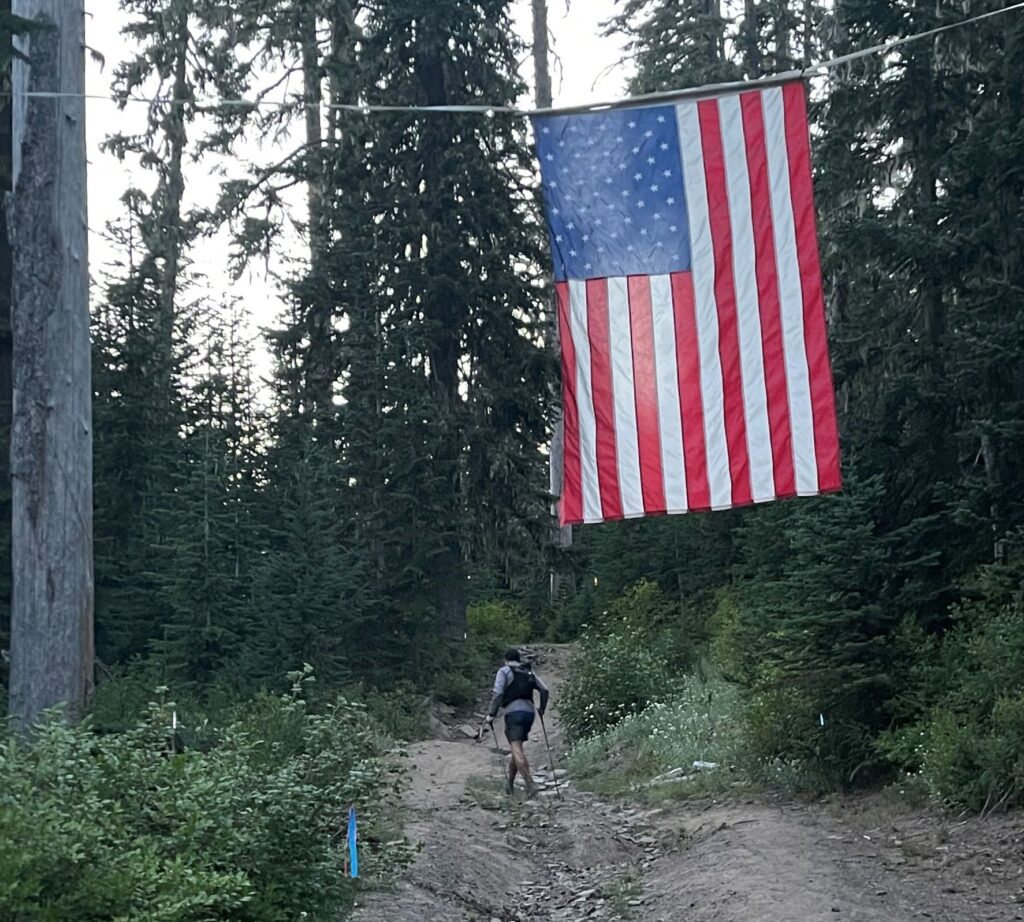
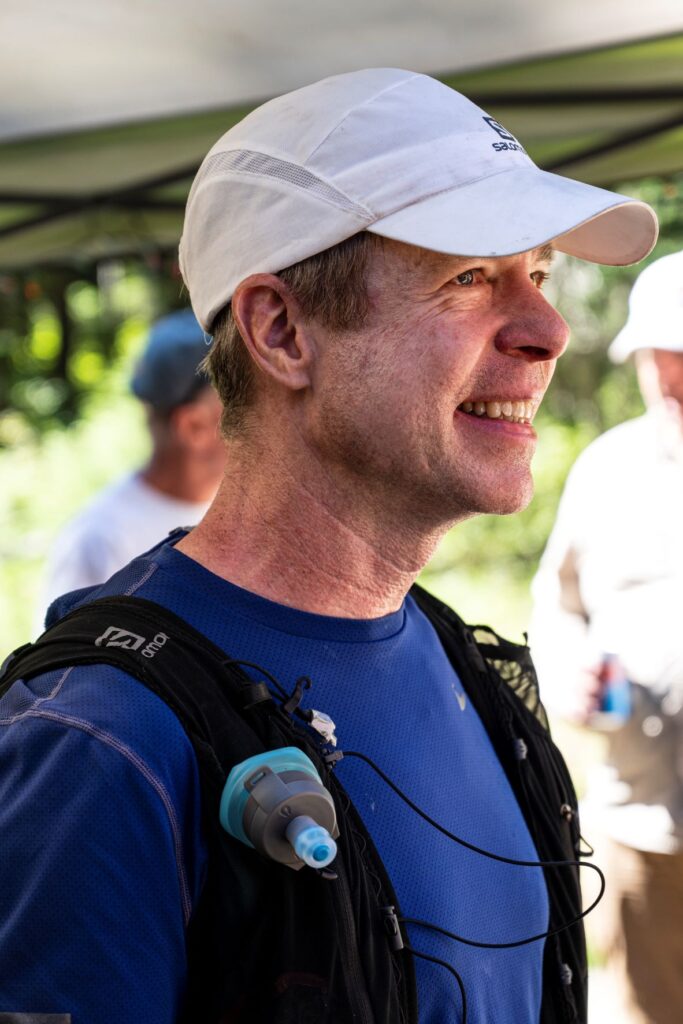
Chain of Lakes to Twin Sisters (Mile 144 to Mile 180)
I knew going into the race that if there was one aid station at which I might choose to sleep, it would be Chain of Lakes. Despite my concern of being passed while I slept, by the time I arrived at the aid station I knew if I didn’t sleep, I’d likely lose even more time by sleepwalking through the rest of the night. I ate a cheeseburger as soon as I arrived, then Heather walked me to one of the sleep tents. Thankfully, the tent had been set up away from the hustle and bustle of the aid station. Heather wrapped me in a cocoon of blankets, set her alarm for one hour, and then waited with the volunteers.
I fell asleep in an instant, and didn’t stir until forty minutes later when Mike Asmus was already in the tent getting ready to lay down on another of the cots. For a moment, I was convinced I hadn’t slept a wink. Then some degree of logic kicked its way into my foggy brain and I concluded that if I had been awake the whole time, I would have heard Mike unzipping the tent and entering rather than discovering his presence only after he was already inside.
After Mike laid down, I stayed in the tent until the full hour I’d allotted was up, but I didn’t fall asleep again. When Heather stepped inside the tent and told me it was time, I sat up, put my shoes back on, and then found my way to a camping chair once again. My body was demanding still more calories, so I ate part of another burger and sipped some hot chocolate before setting out on the trail to the first of the river and stream crossings during this section. In all, I spent two hours at Chain of Lakes aid station. Unsurprisingly, it was my longest stop by a wide margin, accounting for 40% of the total time I spent at all aid stations during the race.
The route from Chain of Lakes to Klickitat has always been my slowest section of Bigfoot 200, and 2022 was no different. I started the section at 4:30 AM and, even though I’d just slept, I wasn’t moving very fast. Although the descent from the aid station to the first water crossing was rocky and slick, someone feeling more alert and energetic could have taken it at a decent pace. I essentially walked the entire way down the short hill. After that first river crossing, I mustered the energy to at least start running the flats and downs again, but I still wasn’t feeling very peppy.
It wasn’t until after the light of day had fully arrived that I decided I needed to alter my course of action, or I might end up moving slowly for many more miles. It was 7 AM, and I was 46-hours into the race. With almost 60 more miles to go, I couldn’t afford to give up whatever lead I had on Chris and the other guys. I decided curling up on the side of the trail just might be enough to snap me out of my lethargy even though I knew I wouldn’t fall asleep.
With my pack as a pillow, I laid down on a soft, grassy patch of earth. My brain relaxed, my body relaxed, and five minutes later I stood up with a new feeling of alertness. I put my pack back on and started moving with a greater sense of purpose, pushing myself rather than loping along in a slow jog.
While Chain of Lakes to Klickitat was still my slowest section of the race, it was a minute-and-a-half per mile faster than I’d run it in any of the previous iterations of Bigfoot. I attribute this to my sleep at the aid station, the large quantity of calories I consumed, and the refreshing, five-minute rest on the side of the trail.
When I arrived at Klickitat aid station, mile 161, I checked in with the volunteers, and then Heather led me over to the crew vehicle. With all the water crossings during the previous section, I needed a shoe change just to be certain no foot problems cropped up during the remaining 48 miles of the race. Once I was seated and had taken my shoes off, I drifted into a very relaxed, unhurried mindset that did not serve me well. After a 2-hour stop only 17 miles earlier, I simply did not need to consume forty minutes relaxing in a camping chair, but I did. Granted, I knew I wasn’t going to catch Jovica, who was still dominating the race, but I had no idea how close behind me Mike, Jake and Chris were. To risk losing whatever lead I had achieved wasn’t the decision of a well-rested mind.
By the time I left the aid station, Chris and Mike had both arrived, branding into my mind the fact that I’d just wasted a lot of time. I started at an easy pace, and then gradually built up my effort to a more intense but still sustainable level. Nagging at the back of my mind was the concern that I’d hear Mike and Chris coming up behind me at any moment.
After my shift to a higher gear, I ran absolutely every hill I could push myself to run throughout this section. I only hiked when I felt the slope was steep enough or long enough to wear me out for the remaining miles of the race. I wanted to widen the gap between me and my pursuers. If I could prevent a recurrence of one or more of them coming into an aid station before I departed, I felt I could create at least a little bit of a psychological impediment to them believing they could catch me. And if they didn’t believe they could catch me, they might not even bother trying. They might instead slip into a more defensive mindset of just protecting the position they were already in.
Like the previous year’s race, the insects were awful during the route from Klickitat to Twin Sisters. Constantly swirling around my head, arms and legs, they’d land, bite, and then swirl around again with their friends looking for the next tasty part of me to land on and feast on. It was a relief when I finally left the insect swarms behind during the last few miles to the aid station.
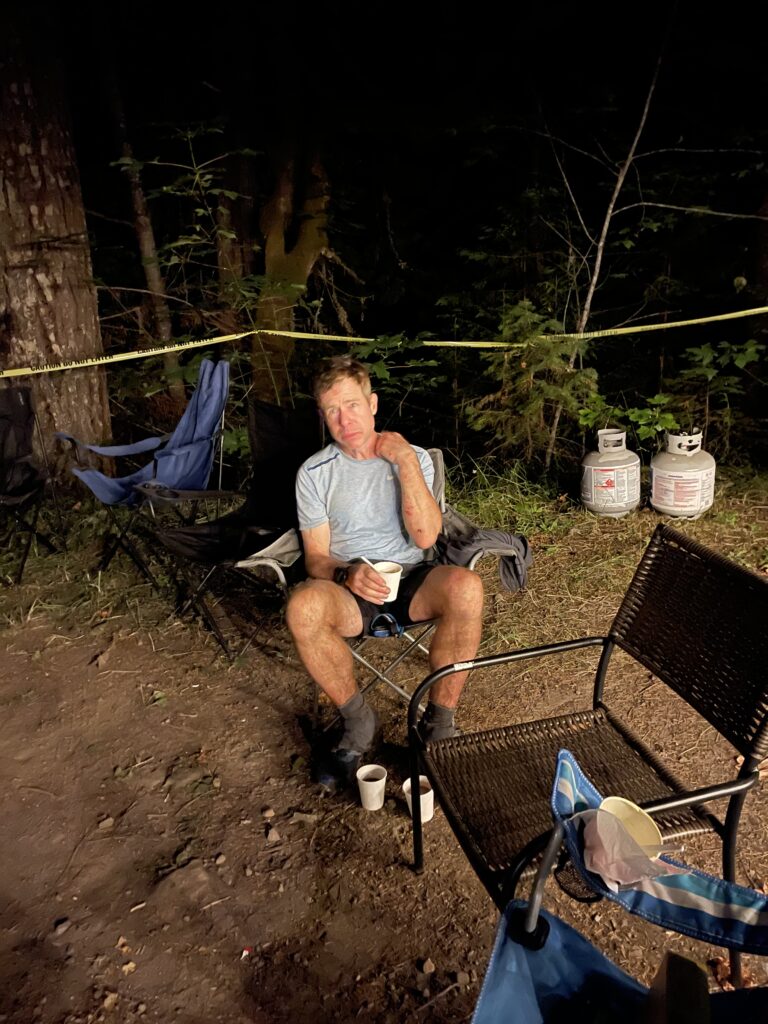
Twin Sisters to Finish (Mile 180 to Mile 209)
I kept my stop at Twin Sisters brief, sticking to my plan of getting out of the aid station before any other runners arrived. Once I was back on the trail, I moved as quickly and efficiently as I could. Because the first couple miles after departing Twin Sisters are shared with the runners coming into Twin Sisters, every bit of distance I put between myself and the aid station before encountering another runner would make the task of catching me seem more insurmountable. I hadn’t gone far along the “back” portion of the out-and-back when I saw Chris approaching. I glanced at my watch. I’d come about 1.2 miles since the aid station, which put Chris 2.4 miles behind me. Plus, he’d lose whatever time he spent at Twin Sisters. Was it enough? I didn’t know. I kept pressing forward.
Unbeknownst to me at the time, Chris managed his time at Twin Sisters very well. He was back on the trail within ten minutes, which meant he was either serious about catching me or serious about keeping Mike and Jake off his tail. Or both. I had a 3 ½ mile lead on him at this point. With 29 miles to the finish, he could close that gap if I blew up or if he was feeling strong enough to push his pace. The race wasn’t over yet.
The first third of the route from Twin Sisters to Owen’s Creek was uneventful. The second third involved the usual clambering over, under or around massive trees that had blown down. Trees seemed to always litter the trail in areas where the mountainside dropped steeply on one side of the trail and climbed steeply on the other side. That darn gravity! Fortunately, the stalwart volunteers on the trail-clearing team must have done some excellent work in the weeks before the race this year, because there weren’t nearly as many trees blocking the trail as in some of the previous years.
The last third of the route to Owen’s Creek was the worst for me. Night had descended sometime along the way, and it wasn’t long afterward when I hit the infamous Green Tunnel. The Green Tunnel is essentially an old forest road that has become completely overgrown with foliage. It had, in fact, become even more overgrown than in any of the previous years. Running through the darkness around 11 PM, my face suffered countless attacks by thin, sticker-laden limbs that would lash across my cheeks and eyes while I focused on the scarcely visible trail that was allegedly somewhere beneath the thick underbrush I was running through. Twice I found myself trapped in webbed networks of multiple fallen deciduous trees. These webs required several frustrating attempts to escape their tentacled grasp. In daylight, or with a mind less sleep deprived than mine, I’m sure there was a pleasant bypass around them, but there was no such yellow brink road for me that night.
I must have checked my GPS watch for signs of forward progress a dozen or more times on this stretch of trail through the Green Tunnel, each time finding I had traveled a shorter distance than I’d hoped. At one point I even wondered if my watch was suffering from some kind of software glitch and was no longer updating my location. Of course, there weren’t any problems with my watch. The problem was that the wearer of the watch was not running very quickly.
Finally, and with great relief, I spotted the lights of Owen’s Creek aid station. And heard the cowbells and cheers from Heather and the volunteers. This should have been a very short stop for me. A minute or two at most. With only eleven miles of the race left, there was no reason to burn time eating or drinking at the aid station. I needed only enough calories to get me down a few miles of forest road and then along a gently rolling, paved, country road to the track at the high school in Randle that was the finish line. Heather re-stocked my pack as soon as I arrived, so it contained plenty of calories for this last, short jaunt. Regardless, my tired mind decided the volunteers’ offer of mashed potatoes and hot chocolate was too tempting to resist. Chris could have been pressing close behind me, possibly turning these last 11 miles into an exhausting battle to the finish, and I sat there eating mashed potatoes. Not my best decision of the race.
Fortunately, Heather stepped in when it became apparent that I might want even more food after finishing the mashed potatoes. She nudged me with a comment regarding needing to get moving. It was enough to snap me out of my lethargy. I stood up and put on my pack. Heather was going to pace me for these last 11 miles, so she’d slipped her pack on a couple minutes earlier. We thanked the volunteers, and then started running down the forest road. When we hit the pavement a few miles later, we shifted to a walk-run approach. We’d run for a minute, or two or three, and then we’d walk for the same amount of time. By this point, I was feeling more confident that Chris wasn’t close behind me, and, even if he was, I felt I could deliver the same sort of effort I’d made when Chris and I were blazing down the descent to Lewis River.
When Heather and I jogged onto the Randle high school campus it was approaching 3 AM. We maintained our leisurely jog most of the way around the track. Then, a hundred meters from the finish line, I glanced over at Heather and said, “We’re going to run this in.” And then I did the best version of a sprint I could manage. I scarcely noticed the heaviness in my 209-mile legs as I blasted to the finish, thankful for my journey and relieved to be able to stop moving forward.
I finished the race in second place. It had taken me 65 hours, 45 minutes. Chris Price finished in third place in 67:10. Jake Donath was fourth in 69:23, and Mike Asmus was fifth in 70:44. I felt that we’d all pushed each other, and had likely all benefited from the sense of competition and the possibility of what might come of it.
I laid down almost immediately on a cot in one of the tents near the finish line. I just wanted to close my eyes briefly. Ten or fifteen minutes later I was up again to pick out my finishers’ belt buckle from the array near the finish line. I ate a pizza created by one of the race volunteers, and chatted with Heather and with the handful of people at the track at that insanely early time of morning. Candice Burt, the woman who had started the 200-mile race trend eight years earlier with the creation of the Tahoe 200, was among those at the finish line to support me and the other runners, as she always seemed to do.
I felt good about my results. I won Bigfoot 200 in 2018 and finished third in 2021. So, with this second-place finish, I’d now occupied all three spots on the podium. I’d been supported first and foremost by Heather, but also by numerous volunteers and staff who helped me and encouraged me during the long journey.
As Heather and I walked slowly to our vehicle, I knew tonight would not be the last time I circled that high school track.
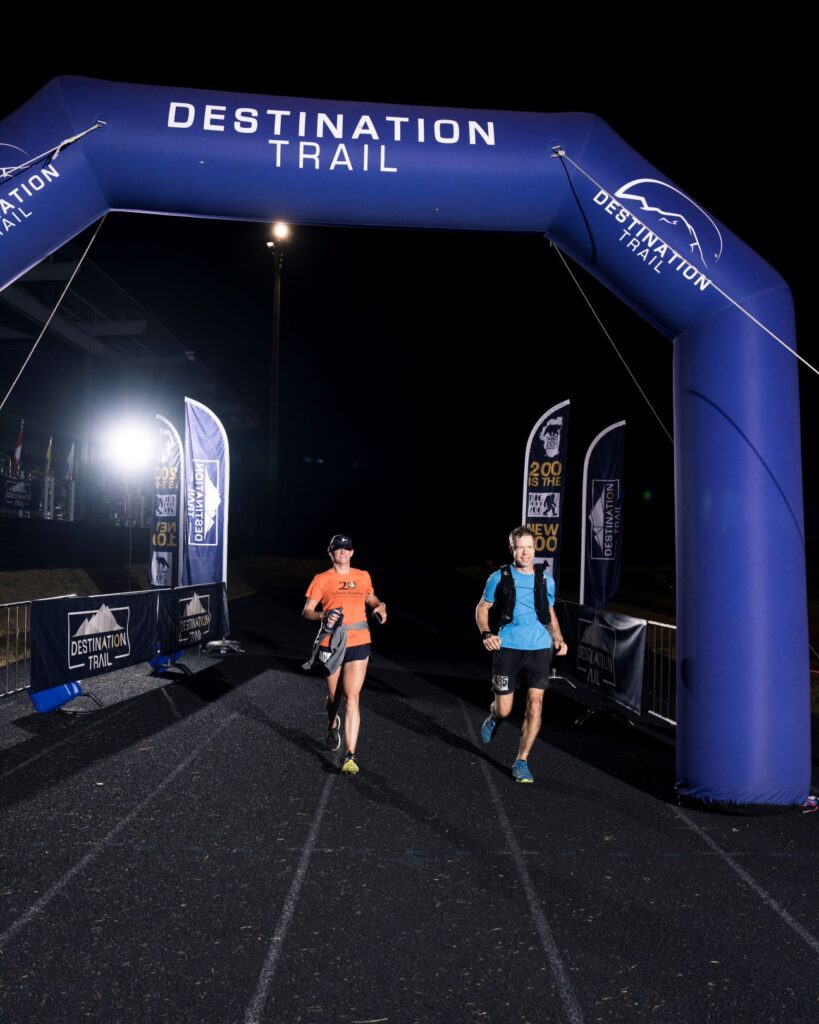
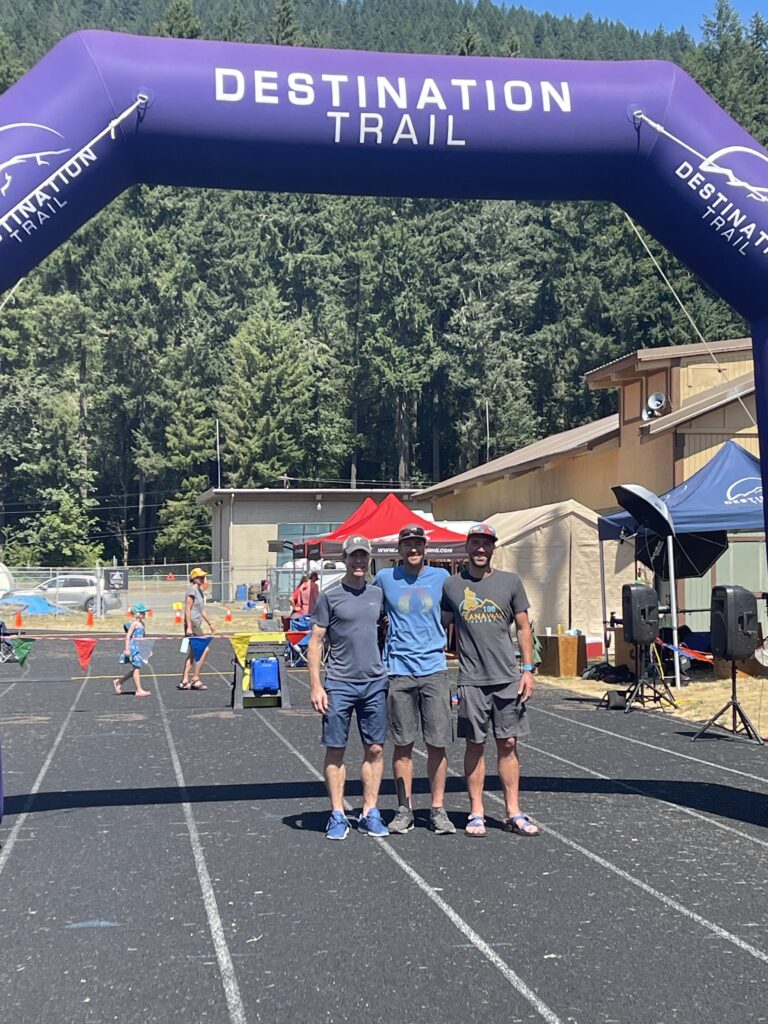
LESSONS LEARNED OR HIGHLIGHTED DURING THE RACE
1. Training with Trekking Poles.
Coldwater Lake to Norway Pass. A lot of people like trekking poles for the balance and support they can provide during rocky, flat and downhill sections. I can appreciate those advantages, but I’ve never found a need for that in my own running. For me, poles are all about climbing. it’s the downward push against the poles during an ascent which takes some of the load off of my legs that is the real value I find in the use of poles.
In years’ past, I typically incorporated a lot of climbing into my training runs, but I would do almost all of it without poles. I usually only added poles into my training during the last few weeks before the race just to remind my upper body muscles what they needed to do on race day. My perspective at the time was that poles took some of the load from my legs and therefore undercut the leg strength training that all the climbing provided me throughout the training season. While that was probably true to a degree in the years when I was doing serious vert every single week, my training this year had intentionally involved lower volumes of both mileage and climbing.
About a third of the way through my training season this year, I made a point of integrating the poles into almost every run that was going to include a lot of steep climbing. By doing a better job developing the upper body muscles used when pushing myself off the poles during an ascent, I intended to counter the effect of my lower volume of hill training.
It was around the time of the climb from the northwest end of Coldwater Lake to the summit of Mount Margaret when I first began to notice the payoff from all my training done with poles. I found that my push-off from the poles felt stronger and more consistent throughout the entire climb. And, as the miles wore on, I was able to sustain this higher level of upper body effort much later in the race than I had in the past. As a result, I’ll likely be integrating the use of trekking poles even earlier into next year’s training.
2. Hill Climbing.
Lewis River to Quartz Ridge. In the latter half of Bigfoot, I found that my stride cadence during climbs was decreasing more than I had hoped it would. As noted above in the analysis of my use of poles, this slowing of my cadence was somewhat offset by my improved upper body strength, but I could still tell that my legs were just not pulling their share of the effort this year when it came to steep climbs. This wasn’t a surprise, since the training season in advance of my 2022 races continued my 2021 trend of doing less climbing. But it was still disappointing.
I don’t plan on shifting back to the more extreme amount of vert I used to do week after week in previous years, so I need to either accept my slower cadence or create better climbing adaptations through more focused training. Accepting that I must get slower isn’t something that I’m willing to do just yet, so that means I’m going to have to put up a fight. Right now, I’m thinking about adding two or three weeks of training where I get back to the 18,000 – 25,000 feet of weekly vert I used to do. My other weeks throughout the season would include varying amounts of climbing depending upon the intended focus for those weeks. This will be very different than the relentless climbing I used to do, but I think that with a focused block like that, I should be able to achieve the same or nearly the same adaptation as in the past, but without the cumulative fatigue that my old approach would likely create in my aging body. Only time will tell.
3. Dealing with Pressure. Hurrying.
Start to Blue Lake. I didn’t experience any occasions at this year’s Bigfoot when I felt hurried or pressured, but I’ve faced this a few times in the past, and I was reminded of the negative impact it can have when I saw another runner near the start of Bigfoot who seemed to be hurrying unnecessarily.
Hurrying is a state of mind, but it often reveals itself through physical actions such as moving in a rushed, uncoordinated fashion, or not paying attention to relevant details. I am rarely in a hurried state of mind when I’m actually running on a race course, but there have been occasions when I’ve arrived at an aid station feeling the pressure of the ever-ticking race clock. In that situation, there have been instances when I’ve hurried through an aid station in an effort to save time. Inevitably, I end up saving only a couple minutes, and the price I pay for those couple minutes is that I don’t eat something I should have eaten or I fail to take an item I meant to carry during the next section. And that price is not worth a paltry two minutes off the clock. For me, the better course of action is to consider in advance what I need at the aid station I am approaching, perform those actions in a focused and efficient manner, and then promptly depart.
I typically carry a set of notes that are specific for each section of the course to assist me with this. The notes aren’t overly detailed, because I want to be able to read the notes as I’m running toward aid station. They cover only a few important points. They tell me how many bottles of water and how many bottles of electrolytes I need in my pack, they alert me if I have a drop bag at the aid station, and they provide reminders that are particular to the upcoming section of the course such as the location of a stream where I’m supposed to fill up a bottle. Such notes keep me focused on the key activities I want to perform at the station rather than focusing on whether I’m getting through the station quickly enough.
I spent a small portion of the first five miles of Bigfoot following someone who was tripping over rocks, moving in an inefficient manner, and increasing his pace on steep uphill portions when he probably should have just held a steady effort level. In short, he was hurrying. I don’t know if he was feeling pressure due to the fact that other runners were right behind him, or whether he had a challenging time goal for this section, but, in any case, there was something going on in his mind that made him think he needed to hurry.
I felt bad for the guy. I wanted to tell him to just relax, to let his mind find peace, and to let his body move how he’s trained it to move. It was far too early in the race to get stressed about anything. But, of course, uninvited advice at mile 4 of a 209-mile race is rarely welcome, so I remained silent and simply wished him good luck when I eventually slipped past him. The good news is that although he may have started with a stressed-out mindset, he must have pulled it together at some point because he finished more than 20 hours before the cutoff in a race where a third of the runners would eventually drop out.
4. Sleep.
Chain of Lakes Aid Station. When to sleep and how much to sleep is always a tough question in a 200-miler. The answer to that question depends upon a lot of factors such as genetics, psychological response to sleep deprivation, and the overall time that a runner spends on the course. In light of that, my commentary regarding my experience with sleep likely won’t apply to a great many people.
In general, as long as I get at least a few hours’ sleep the night before the race, my plan is to rely upon three or four dirt naps alongside the trail rather than a big hour-long block of sleep in a tent. I’ve found that if I wait until I’m so tired that I can hardly stay awake while running, and the only thought going through my mind is whether the ground to either side of the trail is suitable for napping, I will fall asleep a few seconds after laying down. If I choose any other circumstances in which to lie down, it’s pretty much a certainty that I won’t fall asleep. Laying down without falling asleep can still be refreshing, but it is not as valuable as ten minutes of actual sleep.
I have made exceptions to my reliance on dirt naps in several 200-mile races, Tahoe in 2016, Bigfoot in 2022, and Moab in 2019, 2020 and 2021. In three of those five races, I added a 1 to 1.5-hour block of sleep to my plan solely as a result of getting very little sleep the night before the race.
Comparing the results of the five “big block of sleep” races with my seven “dirt nap” races, I believe taking two or three dirt naps, regardless of whether I actually sleep or not during those dirt naps, yields a better finishing result for me than does a bigger block of sleep. But there are a lot of variables that make a definitive conclusion virtually impossible.
The strongest pieces of evidence I have for my conclusion are Bigfoot in 2018 and Tahoe in 2019. At the 2018 Bigfoot I laid down three times for five minutes apiece on the side of the trail, and slept none of those three times. Two of the times, just closing my eyes for five minutes was enough to refresh my mind long enough for the light of morning to arrive. Once morning is upon me, it’s almost always easier to stay alert. With a 59:54 finish, my 2018 race was almost six hours faster than my best “big block of sleep” Bigfoot in 2022. I only have two finishes at Tahoe, but, without going into details, in 2016 I had a good night of sleep before the race, and I slept somewhere between an hour and an hour-and-a-half on the second night of the race. In 2019, with only 30 minutes of sleep the night before the race, and relying solely on dirt naps during the race, I finished in 61:13 which was almost an hour ahead of my 2016 time.
Anecdotal evidence such as my sleep-related comparisons above are inherently inconclusive from a subjective standpoint. There are just too many variables. But since we are all an experiment of one, I am an advocate of not being afraid to draw conclusions from the best information my journey through this experiment of running has given me. Currently, I believe I will perform my best by relying on dirt naps. Years from now, or maybe even months from now, my pace will slow down and I might decide that bigger blocks of sleep would be better for me. For now, I will aim for dirt naps but I will sometimes end up lying down for some good solid sleep anyway. Such is the fun of adventures like these: you just never know what’s going to happen.
Parting Words.
Thanks again to Heather, who supported me through some challenging times on the course. Thanks to the Destination Trail staff and to the volunteers who helped me get to the finish line. And thanks to the three runners—Chris Price, Jake Donath and Mike Asmus—who pushed me to deliver the best performance I could.
See you on the trails!
Wes Ritner
